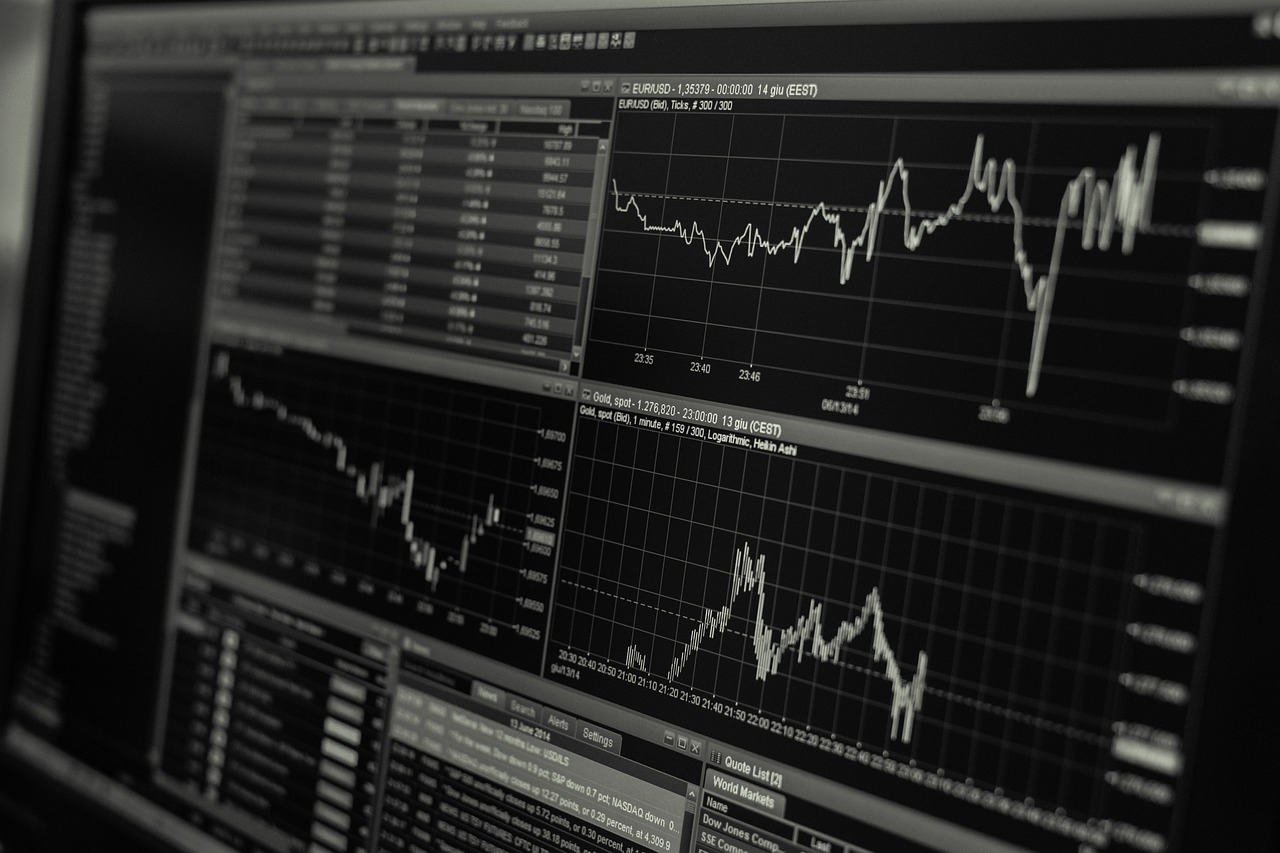The Benefits of Real-Time Data in Technical Analysis
In the fast-paced world of trading, having access to real-time data is akin to having a high-speed internet connection in a world where everyone else is still using dial-up. Imagine trying to navigate a bustling city without a map or GPS; that's what trading without real-time data feels like. This article explores the advantages of utilizing real-time data in technical analysis, highlighting its impact on trading strategies, decision-making, and market predictions for investors and analysts alike.
Real-time data allows traders to make informed decisions quickly, responding to market changes as they happen. This immediacy can significantly improve trading outcomes and reduce the risks associated with delayed information. Think about it: when you receive news about a sudden market shift, being able to act instantly can mean the difference between profit and loss. The quicker you can respond, the better your chances of capitalizing on opportunities or mitigating risks. With real-time data, traders can analyze and react to price movements, news events, and other market stimuli almost instantaneously.
Access to real-time data enhances traders' awareness of market trends and movements. This knowledge enables them to identify opportunities and threats, making it easier to adjust strategies accordingly. For instance, if a trader notices a surge in trading volume for a particular stock, they can quickly evaluate whether this signals a buying opportunity or a potential sell-off. Real-time data acts like a radar, helping traders navigate through the noise of the market and focus on what truly matters.
Real-time data facilitates the identification of emerging market trends, allowing traders to capitalize on profitable opportunities before they become apparent to others. This proactive approach can lead to better investment returns. By continuously monitoring live data feeds, traders can spot trends that might take hours or even days to become evident through traditional data analysis. For example, if a trader sees a consistent upward movement in a stock's price over a few hours, they can take action before the broader market catches on, securing a more favorable entry point.
For short-term traders, real-time data is crucial for executing rapid trades. It enables them to react instantly to price fluctuations, maximizing potential gains in fast-moving markets. These traders thrive on volatility, and real-time data feeds their need for speed. Without it, they risk missing out on critical price movements that can occur within seconds. Think of it as a race; the trader with the most accurate and timely information is often the one who crosses the finish line first.
Even long-term investors benefit from real-time data, as it provides insights into market conditions that can influence investment decisions over time. While these investors may not trade as frequently, having access to real-time information allows them to make more strategic decisions about their portfolios. For instance, if a long-term investor notices a significant change in market sentiment or economic indicators, they can reassess their holdings and adjust their strategy accordingly. This adaptability is essential for maintaining a healthy investment portfolio.
Real-time data plays a vital role in risk management by providing up-to-the-minute information on market volatility. This allows traders to adjust their positions to minimize potential losses effectively. For example, if a trader is holding a position in a stock that suddenly drops due to unexpected news, having real-time data enables them to react quickly, potentially saving them from substantial losses. In trading, timing is everything, and real-time data ensures that traders are equipped to manage their risks effectively.
Using real-time data enhances the accuracy of technical indicators, enabling traders to make better predictions about future price movements. This improvement can lead to more successful trading strategies. Technical indicators, when based on outdated data, can provide misleading signals. However, when updated with real-time information, these indicators reflect the latest market conditions, allowing traders to make decisions based on current realities rather than stale information.
Real-time data allows for the calculation of moving averages that reflect the latest market conditions, providing traders with a clearer picture of price trends and potential reversal points. By incorporating real-time data into moving average calculations, traders can better understand whether a stock is trending upwards or downwards, enabling more informed trading decisions.
Momentum indicators, when updated with real-time data, offer valuable insights into the strength of price movements, helping traders to identify potential entry and exit points more effectively. These indicators can signal whether a stock is gaining or losing momentum, allowing traders to seize opportunities as they arise. In a world where every second counts, having accurate and timely momentum data can be a game-changer.
- What is real-time data? Real-time data refers to information that is delivered immediately after collection, allowing traders to act on the most current market conditions.
- How does real-time data improve trading strategies? By providing immediate insights into market movements, real-time data allows traders to make quick decisions, adjust strategies, and capitalize on opportunities.
- Can long-term investors benefit from real-time data? Yes, long-term investors can use real-time data to stay informed about market conditions and make strategic adjustments to their portfolios.
- What are the key technical indicators enhanced by real-time data? Moving averages and momentum indicators are two key technical indicators that benefit significantly from real-time data.

Enhanced Decision-Making
This article explores the advantages of utilizing real-time data in technical analysis, highlighting its impact on trading strategies, decision-making, and market predictions for investors and analysts alike.
In the fast-paced world of trading, timeliness is everything. Imagine standing at the edge of a cliff, ready to dive into a pool below. If you can see the water’s surface, you’ll make a confident leap. However, if you’re blindfolded, your hesitation might cost you the opportunity. This analogy perfectly encapsulates the essence of real-time data in trading. With real-time data, traders can make informed decisions quickly, responding to market changes as they happen, which is crucial for success.
Consider this: when a major economic report is released or a geopolitical event occurs, the market can react within seconds. Traders equipped with real-time data can seize opportunities or mitigate risks before the rest of the market catches up. This immediacy can significantly improve trading outcomes and reduce the risks associated with delayed information. For instance, a trader who relies on outdated data may miss out on a profitable trade simply because they were unaware of a sudden price shift.
Moreover, real-time data empowers traders to stay ahead of the curve. Here are some key benefits:
- Rapid Response: The ability to act swiftly on new information can mean the difference between a profitable trade and a missed opportunity.
- Informed Choices: Access to the latest market data allows traders to analyze situations more effectively, leading to better decision-making.
- Increased Confidence: Knowing that they have the most current information at their fingertips gives traders the confidence to make bold moves.
Furthermore, the integration of real-time data into trading platforms has revolutionized the way traders approach the market. With advanced analytics and visualization tools, traders can interpret complex data sets quickly, spotting patterns and trends that might otherwise go unnoticed. This capability is especially beneficial in volatile markets, where conditions can change rapidly. By leveraging real-time data, traders can adjust their strategies on the fly, ensuring that they remain aligned with the ever-evolving market landscape.
In conclusion, the role of real-time data in enhancing decision-making cannot be overstated. It transforms the trading experience from reactive to proactive, allowing traders to not just survive but thrive in the competitive world of finance. By embracing real-time data, traders are not only making informed decisions but are also positioning themselves to capitalize on opportunities as they arise, ultimately leading to more successful trading outcomes.
- What is real-time data in trading?
Real-time data refers to information that is delivered instantly as it becomes available, allowing traders to make timely decisions based on the latest market conditions. - How does real-time data improve trading strategies?
Real-time data enhances trading strategies by providing immediate insights into market movements, enabling traders to adjust their strategies quickly and effectively. - Can long-term investors benefit from real-time data?
Yes, even long-term investors can gain valuable insights from real-time data, helping them make informed decisions that align with their investment goals.

Increased Market Awareness
In the fast-paced world of trading, awareness is everything. Imagine being a sailor navigating through stormy seas; without the right instruments to gauge the wind and waves, you’re likely to find yourself capsized. Similarly, traders without access to real-time data are sailing blind. By utilizing real-time data, traders can stay attuned to the ever-shifting currents of the market. This heightened awareness not only empowers them to make informed decisions but also allows them to spot emerging trends and potential pitfalls before they become evident to others.
Real-time data acts like a radar system, constantly scanning the market landscape for changes. With this information at their fingertips, traders can identify opportunities that may otherwise slip through the cracks. For instance, if a particular stock experiences a sudden surge in trading volume, a trader with real-time data can quickly analyze the situation and decide whether to jump on the opportunity or steer clear. This kind of market agility can be the difference between profit and loss.
Moreover, real-time data enhances traders' ability to react to news and events that can influence market behavior. Whether it’s an earnings report, geopolitical news, or economic indicators, being the first to know can provide a significant edge. For example, when a company announces a major partnership or a new product launch, the stock price can react almost instantly. Traders who are plugged into real-time data can capitalize on these moments, often buying in before the rest of the market catches on.
To summarize the benefits of increased market awareness through real-time data, consider the following:
- Timely Responses: Traders can react promptly to market changes, minimizing losses and maximizing gains.
- Opportunity Identification: Real-time data helps in spotting trends and opportunities that can lead to profitable trades.
- Risk Mitigation: Awareness of market movements allows for better risk management and strategic decision-making.
In conclusion, increased market awareness through real-time data is not just a luxury; it’s a necessity for traders aiming to succeed in today’s volatile markets. It’s like having a well-calibrated compass guiding you through the fog—without it, you may find yourself lost, while others sail ahead.
- What is real-time data?
Real-time data refers to information that is delivered immediately after collection, allowing traders to see market movements as they happen.
- How does real-time data improve trading strategies?
By providing up-to-the-minute information, real-time data enables traders to make informed decisions quickly and adjust their strategies based on current market conditions.
- Can real-time data help with long-term investments?
Yes, even long-term investors can benefit from real-time data to understand market trends and conditions that may influence their investment decisions over time.

Identifying Trends
In the world of trading, is akin to finding a golden thread in a tangled web. Real-time data acts as that golden thread, weaving through the chaos of market fluctuations to reveal patterns that might otherwise go unnoticed. When traders have immediate access to this data, they can spot emerging trends almost as soon as they begin to form. This ability to act quickly can be the difference between seizing a lucrative opportunity and watching it slip away.
Consider this: trends are like waves in the ocean. Some are small and barely noticeable, while others can swell into massive forces that reshape the coastline. By utilizing real-time data, traders are better equipped to ride these waves rather than be overwhelmed by them. They can recognize the subtle signs of a trend's inception, whether it's a sudden uptick in trading volume or a shift in price direction. This proactive approach allows traders to capitalize on profitable opportunities before they become apparent to the broader market.
Moreover, real-time data enables traders to categorize trends into various types, such as:
- Uptrends: Characterized by rising prices, where traders can look for buying opportunities.
- Downtrends: Marked by falling prices, prompting traders to consider selling or shorting.
- Sideways Trends: Where prices move within a range, allowing for potential strategies like range trading.
Each of these trend types requires different strategies and approaches. For instance, in an uptrend, a trader might focus on buying on dips, while in a downtrend, they may look for opportunities to sell or short. This level of insight, made possible by real-time data, empowers traders to tailor their strategies to the current market conditions.
Additionally, the ability to identify trends in real-time allows for better risk management. By recognizing when a trend is losing momentum or reversing, traders can adjust their positions accordingly, minimizing potential losses. In essence, real-time data acts as an early warning system, alerting traders to changes in market sentiment before they become significant enough to impact their portfolios.
In conclusion, the importance of identifying trends cannot be overstated. Real-time data transforms the way traders perceive the market, turning them into proactive participants rather than reactive bystanders. By harnessing this powerful tool, traders can not only enhance their decision-making but also position themselves to capitalize on opportunities that others might miss.
Q1: Why is real-time data important for identifying trends?
A1: Real-time data provides immediate insights into market movements, enabling traders to spot emerging trends quickly and make informed decisions.
Q2: How can I use real-time data to improve my trading strategies?
A2: By analyzing real-time data, traders can identify trends and adjust their strategies accordingly, whether that means buying, selling, or holding positions based on current market conditions.
Q3: What types of trends can I identify with real-time data?
A3: Traders can identify uptrends, downtrends, and sideways trends, each requiring different strategies for effective trading.
Q4: How does real-time data impact risk management?
A4: Real-time data allows traders to monitor market volatility and adjust their positions accordingly, helping to minimize potential losses and manage risk effectively.

Short-Term Trading Strategies
When it comes to , the stakes are high, and the pace is fast. Traders who engage in short-term trading are often looking to capitalize on small price movements, which can happen in the blink of an eye. This is where real-time data becomes absolutely crucial. Imagine trying to catch a train that’s already pulling away from the station; you need to be quick, decisive, and informed. Real-time data provides that immediate insight, allowing traders to act swiftly and effectively.
For example, consider a trader who is monitoring a stock that typically fluctuates within a narrow range throughout the day. With real-time data, they can spot a sudden spike in trading volume or a rapid price movement that signals a potential breakout. By having access to this information instantly, they can execute a trade before the opportunity slips away, maximizing their profits. This ability to react promptly to market changes is what sets successful short-term traders apart from the rest.
Moreover, the integration of real-time data into trading platforms allows for the implementation of strategies such as scalping and day trading. Scalping involves making numerous trades throughout the day to capture small price changes, while day trading focuses on buying and selling securities within the same trading day. Both strategies require a keen eye on market movements, and without real-time data, traders would be left in the dark, potentially missing out on lucrative opportunities.
To illustrate the effectiveness of real-time data in short-term trading, let's take a look at a simple comparison of traditional trading versus real-time trading:
| Aspect | Traditional Trading | Real-Time Trading |
|---|---|---|
| Data Refresh Rate | Delayed updates | Instant updates |
| Decision-Making Speed | Slower response | Immediate action |
| Profit Potential | Limited | Maximized |
| Risk Management | Reactive | Proactive |
As shown in the table, the advantages of real-time trading are clear. The ability to receive instant updates allows traders to make proactive decisions, effectively managing risks and maximizing profit potential. In a world where every second counts, being equipped with real-time data is like having a superpower that can elevate a trader's performance to new heights.
In conclusion, short-term trading strategies thrive on the immediacy that real-time data provides. Whether you’re a seasoned pro or just starting out, embracing real-time data can be the key to unlocking your trading potential. So, why wait? Start leveraging real-time data today and watch your trading strategies soar!
- What is real-time data in trading? Real-time data refers to information that is delivered immediately as it changes, allowing traders to make timely decisions based on the latest market conditions.
- How does real-time data improve trading outcomes? It allows traders to respond quickly to market fluctuations, identify trends, and execute trades efficiently, ultimately leading to better investment returns.
- Can long-term investors benefit from real-time data? Yes, even long-term investors can use real-time data to gain insights into market conditions that may affect their investment decisions over time.

Long-Term Investment Insights
When it comes to long-term investing, many people often think that they can simply set their investments on autopilot and forget about them. However, this couldn't be further from the truth! Real-time data is a game changer for long-term investors, providing essential insights that can significantly impact the performance of their portfolios. Imagine trying to navigate a ship across the ocean without a compass; that's what investing without real-time data feels like. It can lead you off course and away from your financial goals.
By utilizing real-time data, long-term investors gain a clearer understanding of the market dynamics that influence their investments. For instance, they can monitor economic indicators, corporate earnings reports, and geopolitical events as they unfold. This information allows them to make informed decisions about when to buy, hold, or sell their assets. In essence, real-time data acts as a radar system, alerting investors to potential storms ahead and helping them steer clear of turbulent waters.
Moreover, real-time data can help investors spot market corrections and other significant shifts that may affect their long-term strategies. For example, if a particular sector begins to show signs of weakness, savvy investors can pivot their portfolios to minimize losses. This proactive approach is crucial, as it allows them to capitalize on opportunities that arise from market fluctuations rather than being caught off guard.
To illustrate the importance of real-time data for long-term investment insights, consider the following table that highlights key market indicators and their impact on investment decisions:
| Market Indicator | Impact on Long-Term Investments |
|---|---|
| Interest Rates | Affect borrowing costs and can influence stock market performance. |
| Inflation Rates | High inflation can erode purchasing power, prompting adjustments in investment strategies. |
| Corporate Earnings | Real-time updates on earnings can signal whether to hold or sell stocks. |
| Geopolitical Events | Can create market volatility; timely information helps in making quick decisions. |
In addition to these indicators, real-time data also helps investors track the performance of their assets against benchmarks. By having access to up-to-the-minute information, investors can assess whether their investments are performing as expected or if adjustments are necessary. This ongoing evaluation is critical for maintaining a healthy portfolio over the long haul.
Ultimately, the integration of real-time data into long-term investment strategies empowers investors to make smarter, more informed decisions. It transforms the investment process from a passive activity into an engaging, dynamic journey. So, the next time you think about your long-term investments, remember that staying informed is key. Embrace the power of real-time data, and watch your investment strategy flourish!
- What is real-time data? Real-time data refers to information that is delivered immediately after collection, allowing investors to react quickly to market changes.
- How does real-time data benefit long-term investors? It provides insights into market conditions, enabling informed decision-making and proactive adjustments to investment strategies.
- Can real-time data help with risk management? Yes, it allows investors to monitor market volatility and adjust their positions to minimize potential losses.
- Is real-time data only for short-term traders? No, long-term investors also benefit significantly from real-time data, as it helps them stay informed about market trends and economic conditions.

Risk Management
When it comes to trading, is not just a strategy; it’s a survival skill. Imagine sailing through a stormy sea without a compass or a map. That’s what trading without real-time data feels like. Real-time data is your compass, guiding you through the unpredictable waves of market volatility. By providing traders with up-to-the-minute information, it allows them to make informed decisions that can significantly minimize potential losses. This immediacy is crucial, especially in a fast-paced trading environment where prices can change in the blink of an eye.
With real-time data, traders can react promptly to market fluctuations. For instance, if a sudden news event impacts a stock's price, having access to real-time data enables traders to adjust their positions quickly, whether that means selling to cut losses or buying to capitalize on a dip. This swift action can be the difference between a small loss and a catastrophic one. Furthermore, traders can set stop-loss orders based on the latest data, ensuring that their investments are protected even in volatile conditions.
To illustrate the importance of real-time data in risk management, consider the following table that compares outcomes based on different data access scenarios:
| Scenario | With Real-Time Data | Without Real-Time Data |
|---|---|---|
| Market Volatility | Immediate reaction to price changes | Delayed response, potential for larger losses |
| Decision Making | Informed and timely decisions | Speculative and reactive decisions |
| Risk Mitigation | Proactive adjustments to positions | Passive approach, higher risk exposure |
This table highlights how crucial real-time data is for effective risk management. By staying informed, traders can not only protect their investments but also position themselves to take advantage of market opportunities. In essence, risk management becomes a dynamic process rather than a static one, allowing traders to adapt to the ever-changing market landscape.
In conclusion, embracing real-time data in trading not only enhances risk management strategies but also empowers traders to navigate the complexities of the market with confidence. The ability to make quick, informed decisions can transform a trader's approach, turning potential pitfalls into stepping stones for success.
- What is real-time data in trading? Real-time data refers to information that is delivered immediately as it becomes available, allowing traders to make timely decisions based on the latest market conditions.
- How does real-time data improve risk management? It allows traders to react promptly to market changes, adjust their positions, and set protective measures like stop-loss orders, thereby minimizing potential losses.
- Can long-term investors benefit from real-time data? Yes, even long-term investors can use real-time data to gain insights into market conditions that may influence their investment strategies over time.
- What are some tools for accessing real-time data? Many trading platforms and financial news websites offer real-time data feeds, including stock prices, economic indicators, and news alerts.

Improved Technical Indicators
When it comes to trading, having the right tools at your disposal can make all the difference. One of the most significant advantages of utilizing real-time data is the enhancement of technical indicators. These indicators are like the compass of a trader; they guide decisions based on statistical analysis of past market data. However, without real-time data, these indicators can be akin to navigating with a map that’s several years out of date. By incorporating real-time data, traders can achieve a clearer and more accurate representation of market movements, leading to better-informed decisions.
For instance, take the moving averages. These indicators smooth out price data to help traders identify trends over a specific period. With real-time data, moving averages become more responsive to current market conditions. Imagine trying to predict the weather with outdated information; it’s likely you’d be caught off guard. Similarly, using stale data for moving averages can lead to missed opportunities or unexpected losses. By continuously updating these averages with real-time data, traders can spot potential reversal points and shifts in market momentum much earlier.
Furthermore, momentum indicators are another area where real-time data shines. These indicators measure the speed of price movements and can provide insights into whether a trend is gaining or losing strength. In a fast-paced trading environment, having access to the latest data means that traders can make quick decisions about when to enter or exit a position. Picture a race car driver who only receives updates about the track conditions every few laps; by the time they get the information, they could already be in trouble. Real-time updates on momentum indicators prevent traders from being blindsided by sudden market changes.
To illustrate the impact of real-time data on technical indicators, consider the following table that compares traditional indicators with those enhanced by real-time data:
| Indicator Type | Traditional Method | Real-Time Enhanced |
|---|---|---|
| Moving Averages | Delayed response to price changes | Quick adaptation to market shifts |
| Momentum Indicators | Infrequent updates | Continuous updates for immediate insights |
| Volatility Indicators | Static view of market conditions | Dynamic view reflecting current volatility |
In summary, the integration of real-time data into technical analysis not only enhances the accuracy of indicators but also empowers traders to make more strategic decisions. Whether you're a day trader looking to capitalize on short-term fluctuations or a long-term investor wanting to keep a finger on the pulse of market trends, real-time data is indispensable. It’s like having a state-of-the-art navigation system that updates in real-time, ensuring you never miss a turn or a crucial opportunity in the market.
- What are technical indicators? Technical indicators are statistical calculations based on historical price and volume data that traders use to forecast future price movements.
- How does real-time data improve trading? Real-time data allows traders to react quickly to market changes, improving decision-making and potentially increasing profitability.
- Can long-term investors benefit from real-time data? Yes, even long-term investors can gain insights from real-time data to make informed decisions about their portfolios.

Moving Averages
When it comes to navigating the unpredictable waters of financial markets, serve as a reliable lighthouse guiding traders through the fog of price volatility. These indicators smooth out price data by creating a constantly updated average price, which helps traders identify trends more clearly. Imagine you’re on a boat in a storm; the moving average is like a steady hand on the wheel, keeping you on course despite the waves. By utilizing real-time data, moving averages become even more powerful, reflecting the most current market conditions and allowing traders to make informed decisions.
There are different types of moving averages, each with its unique advantages. The two most common types are:
- Simple Moving Average (SMA): This calculates the average price over a specified number of periods, providing a straightforward view of price trends.
- Exponential Moving Average (EMA): Unlike the SMA, the EMA gives more weight to recent prices, making it more responsive to new information. This is particularly useful in fast-moving markets where conditions can change rapidly.
Using real-time data to calculate these moving averages allows traders to spot potential trend reversals and continuations more effectively. For instance, when the price crosses above the moving average, it may signal a buying opportunity, while a drop below could indicate a sell signal. By staying updated with real-time information, traders can adjust their strategies on the fly, which is crucial in a market that moves at lightning speed.
To illustrate the impact of real-time data on moving averages, consider the following table:
| Time Frame | Price | SMA (5 Days) | EMA (5 Days) |
|---|---|---|---|
| Day 1 | $100 | $100 | $100 |
| Day 2 | $102 | $101 | $100.67 |
| Day 3 | $101 | $101 | $100.89 |
| Day 4 | $104 | $101.25 | $101.78 |
| Day 5 | $103 | $101.6 | $102.34 |
This table shows how the SMA and EMA react to price changes over a 5-day period. Notice how the EMA reacts more quickly to the latest price changes compared to the SMA. This responsiveness can be a game-changer for traders looking to capitalize on short-term movements.
In summary, integrating real-time data into moving averages not only enhances their accuracy but also empowers traders to make timely decisions. Whether you’re a day trader looking to seize fleeting opportunities or a long-term investor wanting to understand market trends, moving averages—when combined with real-time data—become an indispensable tool in your trading arsenal.
- What is a moving average? A moving average is a statistical calculation that helps smooth out price data by creating a constantly updated average price over a specific period.
- Why are moving averages important in trading? Moving averages help traders identify trends, potential reversals, and entry or exit points, making them crucial for effective trading strategies.
- How does real-time data affect moving averages? Real-time data allows moving averages to reflect the most current market conditions, enhancing their accuracy and making them more responsive to price changes.

Momentum Indicators
Momentum indicators are essential tools in the arsenal of any trader looking to identify the strength of price movements. When updated with real-time data, these indicators provide crucial insights that can significantly enhance trading strategies. Imagine you're driving a car; the speedometer tells you how fast you're going, but it’s the real-time data from the GPS that helps you navigate the twists and turns of the road ahead. Similarly, momentum indicators help traders gauge whether a price trend is gaining strength or losing steam.
These indicators work on the principle that prices tend to move in trends and that the strength of these trends can provide valuable information about future price movements. By analyzing the momentum, traders can make informed decisions about when to enter or exit a trade. For instance, if a momentum indicator shows increasing strength in a price movement, it might suggest that the trend will continue, prompting traders to consider buying. Conversely, a decline in momentum might signal that it's time to exit a position.
Some of the most popular momentum indicators include:
- Relative Strength Index (RSI): This measures the speed and change of price movements, helping traders identify overbought or oversold conditions.
- Moving Average Convergence Divergence (MACD): This indicator shows the relationship between two moving averages of a security's price, helping traders spot changes in momentum.
- Stochastic Oscillator: This compares a particular closing price of a security to a range of its prices over a certain period, indicating potential reversal points.
By leveraging these indicators with real-time data, traders can achieve a more nuanced understanding of market dynamics. For example, a sudden spike in the RSI, when viewed in conjunction with real-time price movements, can alert traders to a potential price reversal much earlier than they might have anticipated. This proactive approach not only enhances trading efficacy but also fosters a more strategic mindset among traders.
In conclusion, momentum indicators, when paired with real-time data, become powerful allies for traders. They transform the way traders interpret market signals, allowing for quicker and more accurate decision-making. As the market evolves, staying ahead of the curve is crucial, and momentum indicators provide that edge, helping traders navigate the often unpredictable waters of financial markets.
- What are momentum indicators? Momentum indicators are technical analysis tools that measure the speed and strength of price movements, helping traders identify potential entry and exit points.
- How do I use momentum indicators? You can use momentum indicators by analyzing their readings in conjunction with price movements to determine whether to buy or sell a security.
- Are momentum indicators reliable? While they can provide valuable insights, momentum indicators should be used in conjunction with other analysis tools and market conditions for the best results.
Frequently Asked Questions
- What is real-time data in technical analysis?
Real-time data refers to information that is delivered instantly as it becomes available. In technical analysis, this means traders can access current market prices, trading volumes, and other relevant metrics without delay, allowing for timely decision-making.
- How does real-time data enhance decision-making for traders?
With real-time data, traders can react swiftly to market changes, which drastically improves their chances of making profitable trades. Instead of relying on outdated information, they can adapt their strategies on the fly, minimizing risks that come with delayed reactions.
- Can long-term investors benefit from real-time data?
Absolutely! Even if you're a long-term investor, real-time data helps you stay informed about market conditions that might affect your investments over time. This insight allows for more strategic decision-making regarding portfolio management.
- What role does real-time data play in risk management?
Real-time data is crucial for effective risk management as it provides up-to-date information on market volatility. Traders can adjust their positions quickly to minimize potential losses, ensuring they are better protected against sudden market shifts.
- How does real-time data improve technical indicators?
Using real-time data enhances the accuracy of technical indicators by incorporating the latest market conditions. This results in more reliable predictions about future price movements, which can significantly improve trading strategies.
- What are moving averages, and how are they affected by real-time data?
Moving averages are statistical calculations used to analyze data points by creating averages of different subsets. With real-time data, moving averages reflect the most current market trends, allowing traders to identify potential reversal points more effectively.
- What are momentum indicators, and why are they important?
Momentum indicators measure the strength of price movements, helping traders identify potential entry and exit points. When updated with real-time data, these indicators provide crucial insights that can lead to more informed trading decisions.



















